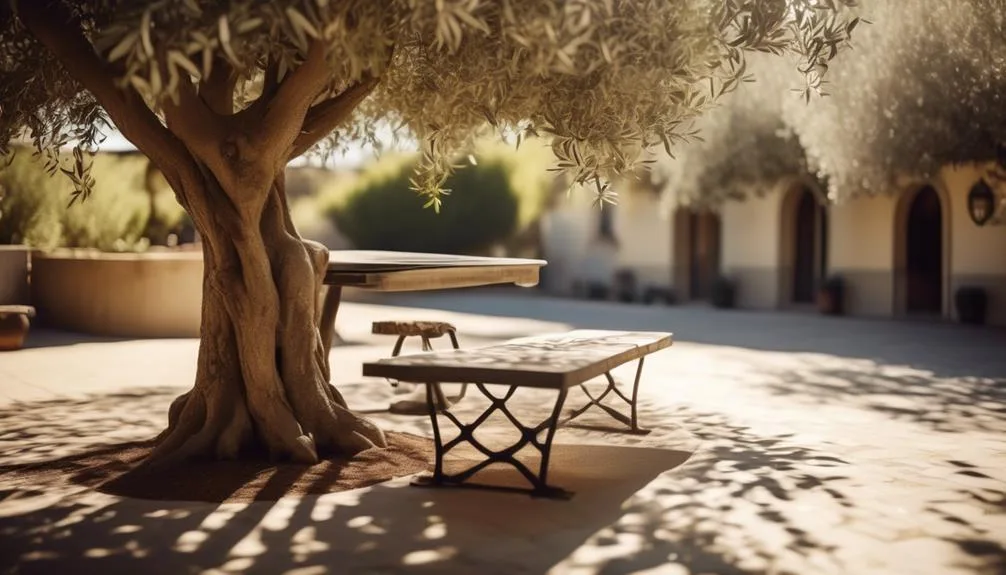You may have heard the expression 'finding shade under an olive tree,' but have you ever wondered if olive trees can actually provide shade? Olive trees are known for their silvery-green leaves and tasty fruits, but their potential to offer shade is often overlooked.
Before you dismiss the idea, there are some interesting facts to consider. Let's explore whether olive trees can truly provide a break from the sun and the factors involved.
Key Takeaways
- Olive trees provide excellent shade potential due to their dense foliage and ability to block sunlight.
- They thrive in sunny and hot conditions, making them suitable for providing shade in outdoor spaces.
- Proper pruning is essential to maximize their shade potential and maintain an open canopy.
- Using olive trees for shade not only enhances the aesthetic appeal of outdoor spaces but also contributes to economic savings on cooling costs and improved air quality.
Shade Potential of Olive Trees
Olive trees provide excellent shade potential, creating a cool and inviting atmosphere for relaxation and outdoor activities. When considering tree selection for shade, the olive tree stands out for its ability to thrive in sunny and hot conditions, making it an ideal choice for providing relief from the sun's intense rays.
Their evergreen nature ensures that they offer shade throughout the year, and their dense foliage effectively blocks sunlight, allowing for a comfortable outdoor experience. With proper pruning, the olive tree can be shaped to maximize its shade potential, making it a versatile option for different outdoor spaces.
Whether it's creating a tranquil spot for a leisurely afternoon or offering a shaded area for outdoor gatherings, the olive tree's shade potential makes it a valuable addition to any landscape.
Ideal Growing Conditions for Shade
To cultivate ideal growing conditions for shade, consider the specific needs of the olive tree, such as sunlight exposure, soil quality, and watering frequency. Olive trees thrive in well-draining soil with a pH level between 5.5 and 7.5. When planting, ensure the soil is rich in organic matter and mix in sand if the soil is heavy. As for watering, olive trees prefer a moderate amount of water, but it is crucial to avoid waterlogged soil. During the growing season, water deeply but infrequently, allowing the soil to dry out between watering. In winter, reduce watering to prevent root rot. Here's a table summarizing the ideal soil and watering requirements for olive trees:
| Ideal Soil Conditions | Watering Requirements |
|---|---|
| Well-draining | Moderate, infrequent |
| pH level 5.5-7.5 | Avoid waterlogged soil |
| Rich in organic matter | Reduce watering in winter |
Maintenance and Pruning for Shade
Considering the ideal growing conditions for shade, maintaining and pruning your olive trees is essential to ensure their health and longevity.
Pruning techniques for olive trees should focus on removing dead or diseased branches, as well as any crossing or rubbing branches that could cause damage. It's also important to prune for shape and size control, which can help to maintain an open canopy for better shade coverage. Regular pruning, ideally in late winter or early spring, encourages new growth and enhances the tree's overall health.
Additionally, a proper watering schedule is crucial for the maintenance of olive trees. Water deeply and infrequently, allowing the soil to dry out between watering to prevent root rot.
These maintenance practices will ensure that your olive trees provide optimal shade while thriving in your garden.
Benefits of Using Olive Trees for Shade
When seeking shade options for your garden, olive trees offer a unique combination of beauty, functionality, and environmental benefits.
The silvery-green foliage and twisted trunks of olive trees provide a Mediterranean charm, enhancing the aesthetic appeal of your outdoor space.
Additionally, these trees can help you save on cooling costs during hot summers by providing natural shade, leading to economic savings.
The air around olive trees is rich in oxygen, contributing to health benefits such as stress reduction and improved air quality.
From an environmental perspective, olive trees offer benefits like soil erosion prevention and providing habitats for wildlife.
Placing olive trees strategically in your garden not only creates a serene and inviting atmosphere but also brings a host of advantages for your well-being and the environment.
Considerations for Using Olive Trees
As you plan to incorporate olive trees for shade in your garden, it's important to consider various factors that can influence their growth and overall impact on your outdoor space. Proper olive tree care is essential for their well-being.
Ensure they receive adequate sunlight, well-drained soil, and regular watering, especially during dry periods. Optimal positioning is crucial for their growth and shade-providing capabilities. Place them where they can receive full sun for at least six hours a day.
Additionally, consider the mature size of the olive trees and plant them with enough space to reach their full potential without overcrowding other plants or structures. By carefully considering these factors, you can ensure that your olive trees thrive and provide the desired shade in your garden.
Conclusion
Incorporating olive trees for shade is a great choice, given their expansive canopies and ability to thrive in sunny climates. By implementing proper care, these trees can offer a cool and serene environment.
Consider the advantages and factors involved, and you may discover that olive trees are an ideal solution for enhancing shade in your outdoor space.
Their presence not only provides relief from the sun but also adds a touch of natural beauty to your surroundings, creating a tranquil and inviting atmosphere for relaxation and enjoyment.

